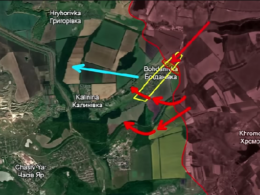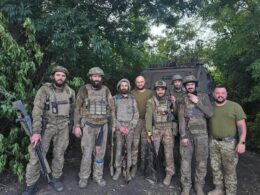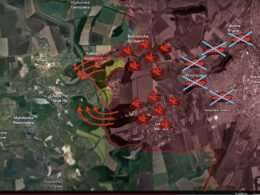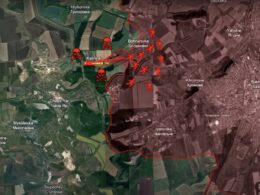Day 1011
On 30 November, there are many important updates from the Chasiv Yar direction in Donetsk Oblast. Here, the battle for the main Ukrainian stronghold took a dramatic turn as Russian forces intensified their efforts to establish a foothold on the left bank of the canal.
What Russians initially thought was a successful breakthrough quickly unraveled into chaos with devastating consequences for their troops and mechanized assault groups.

After a 3-month campaign, Russian forces established a narrow bridgehead on the West Bank of the canal just near Chasiv Yar near Kalynivka. Once they gained control of most of Kalynivka and secured the northern flank, they moved into the second phase of their battle plan.
Kalynivka offered several tactical advantages for the Russian forces, including the canal crossing, local houses, and nearby forests.

The canal crossing allowed them to deploy troops across with at least some chance of survival, avoiding completely suicidal cross-canal attacks. Within such conditions, the surviving infantry could also conceal in the houses and forest, gathering reserves for planned wave assaults.
After hundreds of attacks over the months, Russian stormtroopers used forest positions to launch assaults from the North toward Chasiv Yar's and Zhovtnevyi districts. Artillery and air support tried to soften Ukrainian positions, reducing much of the residential area to ruins. However, the Stormtroopers still had to cross a 500-meter open field on foot, leaving them exposed to Ukrainian drones and artillery.

These conditions led to highly attritional assaults, with many Russian waves suffering heavy casualties, often with no survivors. Ukrainian forces recognized this as the logical Russian attack route, the only way to strike Zhovtnevyi District. They focused artillery fire and drone surveillance on the fields while also scattering landmines. This created a deadly kill zone where large groups of Russian stormtroopers were wiped out during their assault, drastically reducing their survivability and allowing only a few to reach the ruined district of Chasiv Yar.
Russian command launched wave after wave of assaults across the open field, allowing survivors to regroup on the outskirts of the town for more organized attacks.

These attack groups targeted the residential district made up of one-story houses and were supported by Russian positions in the highrise buildings of the canal district, which provided fire control and a clear view of Ukrainian positions.
The combination of high-rise fire control, relentless wave attacks, and air strikes forced Ukrainian fighters in the NV district to pull back slightly to the West as their positions became increasingly risky and offered little tactical advantage. Russian forces faced severe logistical challenges despite establishing a presence near the canal. Air strikes had destroyed much of the local infrastructure, forcing troops to rely on basements that offered no suitable firing position.
The destruction of the only road bridge linking Russian forces across the canal further compounded the issue, preventing supply deliveries. Any logistical support had to cross the same kill zone controlled by Ukrainian artillery and drones. Additionally, Ukrainian drones maintained fire control over the Russian positions, eliminating any forces attempting to move in or out of the basements while artillery further suppressed them.
Russian commanders overlooked the logistical issues, mistakenly assuming that Russian forces in the basement of the demolished residential district had secured the area and that mechanized assaults could proceed toward the town center. A column of 7 BMD-4s carrying 50 soldiers from specialized Airborne units was deployed along the railway embankment and nearby bridge north of the captured Zhovtnevyi district.
However, they quickly found themselves in the Ukrainian kill zone, where Ukrainian strikes destroyed the entire column. Landmines placed by Ukrainians obliterated many vehicles, causing panic and forcing others to hold, making them even easier targets. Ukrainian FPV drones then attacked the advancing remnants, supported by artillery, and the entire Russian column was wiped out before reaching the bridge head they believed was secure.
Overall, the developments around Chasiv Yar highlight the Russian inability to consolidate control and supply the captured areas adequately. This was further worsened by the predictability of their attacks, which the Ukrainians managed to exploit. The predictability of their attacks enabled the Ukrainians to estimate their planned routes of attack, destroying their mechanized columns, which led to no territorial gains for the Russians in this sector.
Ukrainian forces do not let their guards down even in less active directions like Chasiv Yar, successfully displaying their adaptability and successful coordination and organization of defenses in the form of tactical kill zones.
In our daily frontline report, we pair up with the military blogger Reporting from Ukraine to keep you informed about what is happening on the battlefield in the Russo-Ukrainian war.
Read also:
- Frontline report: Russia’s high-rise assault in Toretsk fails as Ukrainian forces use FPVs to decimate Russian troops
- Frontline report: Ukraine threatens to collapse stranded Russian bridgehead in Chasiv Yar
- Frontline report: Ukraine launches record 20-drone strike on Moscow, hits another 5 regions to expose Russian air defenses and cripple military hubs





